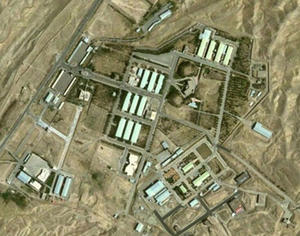IranIAEA: Iran finished removing evidence of illicit nuclear work at Parchin
Iran, implausibly, may explain away its uranium enrichment activities by saying it needs the enriched material for civilian reactors and medical research (although the sheer quantities of uranium it enriches bear no relationship to either need); warhead design is done by a few engineers at secret locations; there is one activity – testing of the triggering mechanism for a nuclear bomb – that cannot be explained away (because these triggers do not have any other use) or hidden (because the testing leaves unmistakable traces); Iran has been conducting tests on a triggering mechanism for nuclear warheads at a military base called Parchin, south of Tehran, and has blocked access of UN inspectors to the site; detailed satellite imagery shows that Iran has been engaged in a frantic effort to scrub all evidence related to nuclear weapons testing activity at the military base by demolishing buildings and removing large quantities of soil that might hold traces of illicit nuclear work; the IAEA says that Iran has succeeded in its clean-up effort

Satellite image of Iran's nuclear trigger test site at Parchin // Source: laodong.com.vn
Yukiya Amano, director of the UN International Atomic Energy Agency (IAEA) said in a talk yesterday that his agency’s inspectors had made no progress in “a yearlong effort” to determine whether Iran had conducted research and tests required to build nuclear weapons.
IAEA inspectors are scheduled to meet next week with Iranian officials in an effort the revive discussions of the military aspects of Iran’s nuclear program. “We have intensified our dialogue with Iran this year, but no concrete results have been made yet,” Amano said in a talk at the Council on Foreign Relations.
To build nuclear weapons, a country needs to do three things:
- Enrich uranium to weapon-grade level, or separate plutonium from spent uranium rods. According to the IAEA, Iran has enriched eight tons of uranium to 5 percent, and 238 kilograms of uranium to 20 percent. Iran, in short order, could enrich this uranium to weapon-grade 95 percent, meaning that it would then have enough material for five or six Hiroshima-size bombs.
Iran plans to build not only uranium-based bombs, but bombs using plutonium as well. In August the civilian reactor at Bushehr became operational, supposedly under Russian supervision. In October, however, the Iranian inexplicably removed fuel rods from the reactor’s core. The Iranians say that the removal was done for safety reasons, and that the rods have since been returned.
Whether or not the Iranian claim is true, the fact remains: Iran removed enough spent uranium from Bushehr which, if reprocessed, would yield about 220 pounds of weapon-grade plutonium – enough for about twenty-four Nagasaki-size bombs. - The second thing required for a bomb is a warhead design. Iran has received different designs from Pakistan and North Korea, and its own scientists have been working on warhead designs for a decade. Note that most of the Iranian scientists killed by Israeli agents in the past half-decade were involved in the warhead design part of the operation.
- Testing the triggering mechanism. Creating a nuclear fusion is a demanding task, dependent on achieving a simultaneous explosion of several electronic triggers placed on the outer shell of the warhead. By “simultaneous” we mean literally “at the very sane tine” – not trigger can explode even a fraction of a nanosecond too late or the fusion would not occur.
No one has any doubt that Iran is pursuing nuclear weapons, but it is possible to want enriched uranium for civilian nuclear reactors or medical research. The sheer quantities of uranium Iran is enriching 5 percent reactor grade, however, go far beyond what a country the size of Iran would need for civilian reactors, and the medical research being done in Iran is so insignificant, that even if the few researchers engaged in such research would need the 20 percent enriched uranium typically used in such research, they would be hard-pressed to use one-tenth of 1 percent of the 238 kg Iran has already enriched to this level – and Iran continues to enrich uranium in both categories.
The warhead design is done by small groups of engineers in secret locations, and there is no way to prove that such design work is even being done.
There is no way, however, to explain away the testing of the exquisitely precise triggering mechanism needed for a bomb because they have no other use except in a nuclear weapon.
Iran has been conducting weapon-related triggering tests at a military base called Parchin, south of Tehran.
IAEA inspectors have been seeking access to Parchin, but so far have been rebuffed.
The Los Angeles Times reports that detailed satellite imagery shows that Iran has been engaged in a frantic effort to scrub all evidence related to nuclear weapons testing activity at the military base by demolishing buildings, removing large quantities of soil that might hold traces of illicit nuclear work, and using bulldozers to change the base’s landscape .
“What we are asking in the negotiations is to have access to sites, information and people,” Amano said, although experts say that by now, after months of scrubbing, there would be no evidence of testing left.
The Times notes that the IAEA reported last month that Iran had added to its stockpile of medium-enriched uranium and had installed new centrifuges at two nuclear facilities. Once operational, those could double the rate of uranium enrichment.
